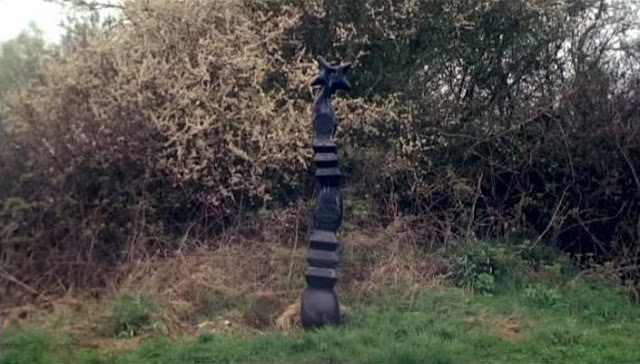I. The site of the impact of the Wold Cottage meteorite, the first recorded in Britain (on 13th December, 1795), photographed by Patrick Keiller. The monument dedicated to "this extraordinary stone, in breadth 28 inches, in length 36 inches" was built by Edward Topham in 1899.
II. Nelson's Needle, Portsmouth, photographed by Matthew Flintham, whose PhD thesis formed part of the AHRC funded project, 'The Future of Landscape and the Moving Image', that enabled the writing and filming of Keiller's Robinson in Ruins (2010). Keiller's film is one of the most vital reflections on "the problem of England", here the crisis of its capitalism, since he last made one. A few notes as to why:

"It is a journey to the end of the world."
--the first words of London, 1994, narration by Patrick Keiller.
The Victory, Nelson's flagship, is preserved at Portsmouth, and is the principal monument of the 18th century British Navy (the largest industrial unit of its day in the Western world), on whose supremacy was built the capitalism of the land, finance and commercial services centred on the city of London, and which dominates the economy of the South of England. Those of us aesthetes who view the passing of the visible industrial economy with regret, and who long for an authenticity of appearance based on manufacturing and innovative modern design, are inclined to view this English culture as a bizarre and damaging anachronism. But if so, it is not an unsuccessful one.
--Robinson in Space, 1997, narration by Patrick Keiller.
[Robinson] had read that one of the factors that had enabled industrial capitalism to develop first in England was the mobility of the previously settled agricultural workforce. Such labour market flexibility however derived not from any Anglo-Saxon customary freedoms, but from government legislation, an act to prevent the removal of poor persons until they shall actually become chargeable. The 1795 amendment to the Settlement Act: "in the interest of freeing hands to go where burgeoning capitalist enterprise needed them most." That same year, a meteorite fell in Yorkshire, which confirmed the reality of meteorites, and led Robinson to conclude that a meteorite fall necessarily coincides with an event of major historical significance.
--Robinson in Ruins, 2010, narration by Patrick Keiller.
Matter, having received into itself individuality, form, as is the case with the heavenly bodies, has ceased to be abstract individuality; it has become concrete individuality, universality. In the meteors, therefore, abstract-individual self-consciousness is met by its contradiction, shining in its materialised form, the universal which has become existence and nature. Hence it recognises in the meteors its deadly enemy, and it ascribes to them, as Epicurus does, all the anxiety and confusion of men.
--Karl Marx, The Difference Between the Democritean and Epicurean Philosophy of Nature, doctoral dissertation, 1841.
He was reading Karl Polanyi's The Great Transformation, published in 1944, which located the origin of twentieth century catastrophe in the development of market society in England. Polanyi accorded great significance to the system of poor relief, devised by the Berkshire magistrates on May 6th, 1795, at the Pelican Inn, in Speenhamland, a part of Newbury. The system guaranteed a minimum income linked to the price of bread, which had risen steeply. It offered landless agricultural workers some protection from the displacement intended by the changes to the settlement act. Polanyi argued that laissez-faire was planned, whereas Speenhamland was society's spontaneous reaction to the disasters that were accompanying its imposition. "The idea of a self-adjusting market," he wrote, "implied a stark utopia. Such an institution could not exist for any length of time without annihilating the human and natural substance of society."
--Robinson in Ruins, 2010, narration by Patrick Keiller.
It seems to be easier for us today to imagine the thoroughgoing deterioration of the earth and of nature than the breakdown of late capitalism; perhaps that is due to some weakness in our imaginations.
--Fredric Jameson, quoted by Keiller at the beginning of Robinson of Ruins, from The Seeds of Time (Columbia UP, 1996), p.xi.
I recently came across a description, in Kitty Hauser’s Bloody old Britain, of O.G.S. Crawford’s photography: "Like photographers of the New Objectivity, clarity was his goal. Like them, he favoured stark contrasts, with no blurring or mistiness. His focus, like theirs, was on the object or the scene in front of him, which it was his aim to illuminate as clearly as he could. [...] It was commitment that lit up his photographs [...] Such photographs suggest a love of the world that was almost mystical in its intensity." I had forgotten that photography is often motivated by utopian or ideological imperatives, both as a critique of the world, and to demonstrate the possibility of creating a better one, even if only by improving the quality of the light.
--Patrick Keiller, "Landscape and Cinematography", Cultural Geographies 16, 2009, p.413.
It would be best, perhaps, to think of an alternate world — better to say the alternate world, our alternate world — as one contiguous with ours but without any connection or access to it. Then, from time to time, like a diseased eyeball in which disturbing flashes of light are perceived or like those baroque sunbursts in which rays from another world suddenly break into this one, we are reminded that Utopia exists and that other systems, other spaces, are still possible.
--the final words of Frederic Jameson's Valences of the Dialectic (Verso, 2009), p.612.

 1876 Gustave Caillebotte.jpg)


































